Enigmatic Figure Dated Back To 40,000 From Prehistoric Stadel Cave, Germany
A. Sutherland - AncientPages.com - On August 25, 1939, archaeologists working at a Paleolithic site called Stadelhole ("stable cave") at Hohlenstein ("hollow rock") in the Lone valley, southern Germany, uncovered hundreds of mammoth ivory fragments.
About 40,000 years ago, at the beginning of the upper paleolithic period, the Swabian Jura was part of the living area of the early, anatomically modern, humans (homo sapiens).
Archaeologists found evidence that these prehistoric people, lived in several caves: they used campfires, tools, weapons and jewelry made out of stone, bone, antlers and ivory.
Moreover, they also sculptured small figurines depicting dangerous animals such as cave-bears and cave-lions, using stone tools out of mammoth ivory.
The tallest and most spectacular of the ivory figurines is the Lion Man, a fabulous therianthropic creature.
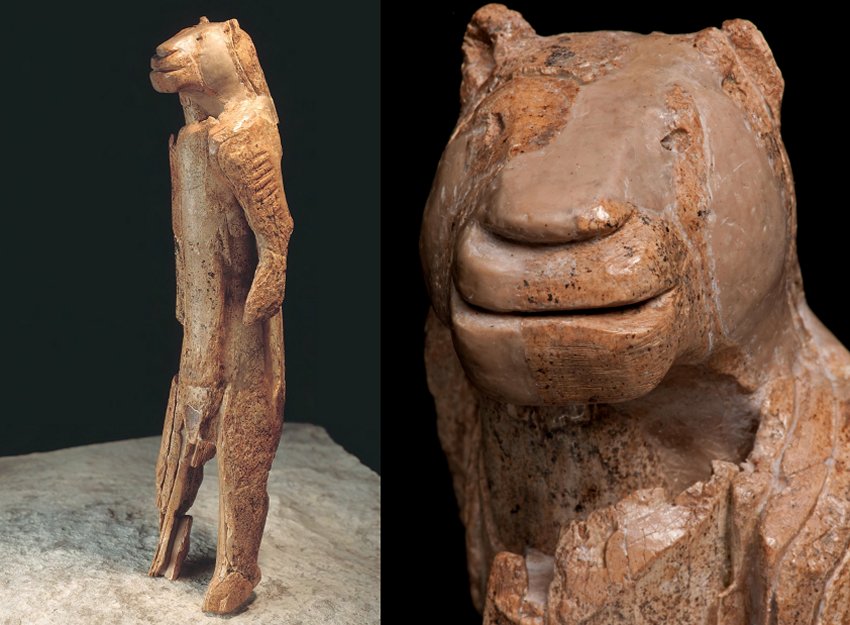
For more than 70 years, archaeologists have been piecing together the 'Lion man' out of mammoth ivory fragments.
Unfortunately, just one week later, before archaeologists could complete their fieldwork and analyze the finds, World War II began. The team was forced to quickly fill the excavation trenches using the same soil in which they found the ivory pieces.
Among the fragments, there were several pieces of the so-called 'Lion man' - one of the oldest and certainly one of the most remarkable statuettes in human history.
For more than 70 years, archaeologists have been piecing together the fragmented sculpture of 'Lion man' out of mammoth ivory fragments.
Their work took time because important parts of the figurine were still missing.
Surprisingly, in 2009, new excavations inside the Stadel Cave rediscovered of the original finding place of the ‘Lion Man’ fragments unearthed in 1939.
They were able to retrieve numerous additional fragments of the figure. It's the tallest and most spectacular of the ivory figurines discovered in four caves. The figurine that combines animal and human attributes, is 29.6 cm (11.7 inches) in height, 5.6 cm wide, and 5.9 cm thick.
The animal part is represented by the lion-head, the long shaped body and the arms formed as forelegs and paws of a big cat, the human part by the legs and feet, as well as the upright position.
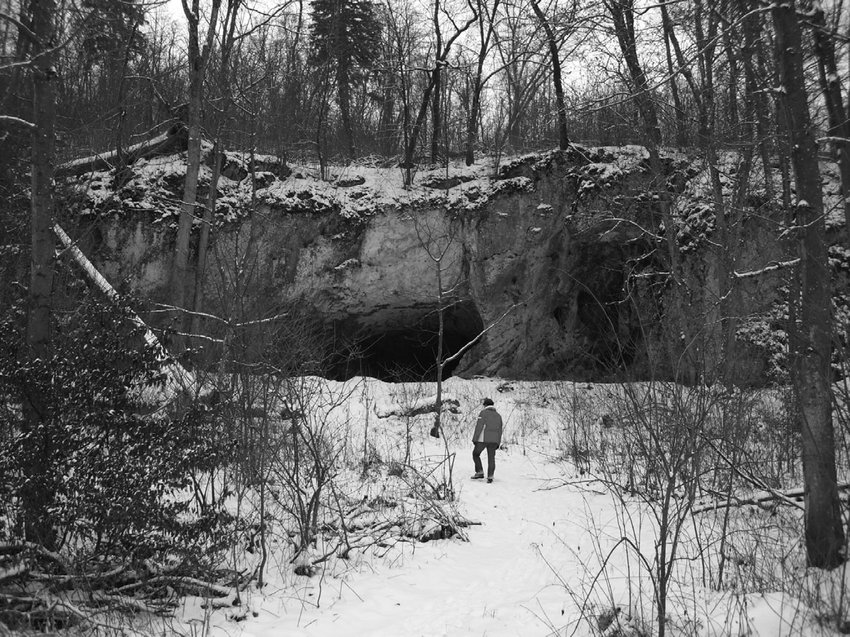 Hohlenstein-Stadel Cave: The entry to the Stadel Cave is located only a few meters above the valley floor and is not visible from the Vogelherd. The Löwenmensch statuette was found in a deep section inside this cave and was intentionally deposited. Photo by Martin Porr
Hohlenstein-Stadel Cave: The entry to the Stadel Cave is located only a few meters above the valley floor and is not visible from the Vogelherd. The Löwenmensch statuette was found in a deep section inside this cave and was intentionally deposited. Photo by Martin Porr
It's unclear whether the figurine represents a man or a woman. From time immemorial, the lion has been viewed as a symbol of the masculine virtues of courage and strength. Shamans still exist today in the Amazon region and Australia. Most of them are men.
On the other hand, the figure has some perplexing features. The navel, for example, a symbol of childbirth, is especially pronounced. A horizontal crease runs across the lower abdomen, a feature that is typically female.
The ‘Lion Man’ - currently on display in the City Museum of Ulm, in Germany - represents a unique relic, carved out of woolly mammoth ivory using a flint stone knife.
It is also very early prehistoric sculpture dated back to the Upper Paleolithic of about 40,000 BC.
Written by – A. Sutherland AncientPages.com Staff Writer
Copyright © AncientPages.com All rights reserved. This material may not be published, broadcast, rewritten or redistributed in whole or part without the express written permission of AncientPages.com
Expand for referencesMore From Ancient Pages
-
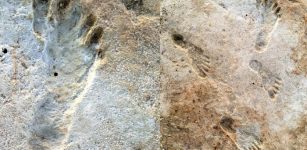 What Can Fossil Footprint Discoveries Tell Us About The Past?
Featured Stories | Aug 16, 2023
What Can Fossil Footprint Discoveries Tell Us About The Past?
Featured Stories | Aug 16, 2023 -
 Does This Cathedral Offer Evidence Our Calendar Is ‘Missing’ 297 Years?
Featured Stories | May 6, 2022
Does This Cathedral Offer Evidence Our Calendar Is ‘Missing’ 297 Years?
Featured Stories | May 6, 2022 -
 Mansehra Rock Edicts – Last Words Of Emperor Ashoka
Featured Stories | May 27, 2019
Mansehra Rock Edicts – Last Words Of Emperor Ashoka
Featured Stories | May 27, 2019 -
 Underwater Excavations: Greek And Danish Archaeologists Research Ancient Harbor Town Lechaion
Archaeology | Dec 25, 2015
Underwater Excavations: Greek And Danish Archaeologists Research Ancient Harbor Town Lechaion
Archaeology | Dec 25, 2015 -
 Ancient Syriac Epitaphs Discovered In Tomb Of Priest Monoha Shed New Light On The Assyrian Empire
Archaeology | Dec 23, 2019
Ancient Syriac Epitaphs Discovered In Tomb Of Priest Monoha Shed New Light On The Assyrian Empire
Archaeology | Dec 23, 2019 -
 Anartes: Forgotten Celtic Tribe And The Hercynian Forest With Strange Animals
Featured Stories | Jun 18, 2024
Anartes: Forgotten Celtic Tribe And The Hercynian Forest With Strange Animals
Featured Stories | Jun 18, 2024 -
 The Man Who Took The Greatest Alchemy Secret Of All Time To His Grave
Ancient Mysteries | Jul 16, 2020
The Man Who Took The Greatest Alchemy Secret Of All Time To His Grave
Ancient Mysteries | Jul 16, 2020 -
 Eastern Baltic’s Communities Of First Farmers And Hunter-Gatherers Merged Slowly
Archaeology | Dec 10, 2023
Eastern Baltic’s Communities Of First Farmers And Hunter-Gatherers Merged Slowly
Archaeology | Dec 10, 2023 -
 Why Were Ancient And Medieval People Horrified Of The Night?
Featured Stories | Nov 11, 2024
Why Were Ancient And Medieval People Horrified Of The Night?
Featured Stories | Nov 11, 2024 -
 Historical Enigma Of The Ancient Werewolf Ruler – What Powers Did He Possess?
Ancient Mysteries | Jan 9, 2025
Historical Enigma Of The Ancient Werewolf Ruler – What Powers Did He Possess?
Ancient Mysteries | Jan 9, 2025 -
 What Fossils Reveal About Hybridization Of Early Humans – History Of Humankind Is More Complex Than Previously Thought
Archaeology | Sep 6, 2022
What Fossils Reveal About Hybridization Of Early Humans – History Of Humankind Is More Complex Than Previously Thought
Archaeology | Sep 6, 2022 -
 New York’s Queen Of Thieves Fredericka Mandelbaum Opened Marm’s Grand Street School For Criminals
Featured Stories | Jul 24, 2024
New York’s Queen Of Thieves Fredericka Mandelbaum Opened Marm’s Grand Street School For Criminals
Featured Stories | Jul 24, 2024 -
 Precious Ancient Chinese Immortality Suits Made Of Jade
Artifacts | Aug 22, 2015
Precious Ancient Chinese Immortality Suits Made Of Jade
Artifacts | Aug 22, 2015 -
 Ancient Secrets Of The Theopetra Cave: World’s Oldest Man-Made Structure And Home To Humans 130,000 Years Ago
Civilizations | May 12, 2016
Ancient Secrets Of The Theopetra Cave: World’s Oldest Man-Made Structure And Home To Humans 130,000 Years Ago
Civilizations | May 12, 2016 -
 Ancient DNA Shows Neanderthals Used Plant-Based Medicine To Treat Pain And Illness
Archaeology | Mar 9, 2017
Ancient DNA Shows Neanderthals Used Plant-Based Medicine To Treat Pain And Illness
Archaeology | Mar 9, 2017 -
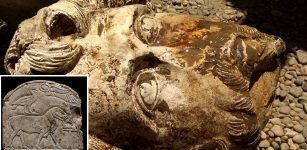 Ancient Shrine Of God Osiris-Ptah Neb And Rare Bust Of Emperor Marcus Aurelius Discovered In Egypt
Archaeology | Apr 28, 2018
Ancient Shrine Of God Osiris-Ptah Neb And Rare Bust Of Emperor Marcus Aurelius Discovered In Egypt
Archaeology | Apr 28, 2018 -
 Ancient Greek Inscription Could Reveal Biblical Saint Peter’s Birthplace – Archaeologists Say
Archaeology | Aug 29, 2022
Ancient Greek Inscription Could Reveal Biblical Saint Peter’s Birthplace – Archaeologists Say
Archaeology | Aug 29, 2022 -
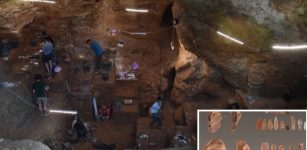 Stone Tools In Lapa do Picareiro Cave Reveal Modern Humans Reached Western Parts Of Europe 5,000 Years Earlier Than Previously Thought
Archaeology | Sep 30, 2020
Stone Tools In Lapa do Picareiro Cave Reveal Modern Humans Reached Western Parts Of Europe 5,000 Years Earlier Than Previously Thought
Archaeology | Sep 30, 2020 -
 Ancient Secrets Of The Amazon Jungle – Dangerous Expeditions And Hidden Treasures – Part 1
Ancient Mysteries | Mar 1, 2019
Ancient Secrets Of The Amazon Jungle – Dangerous Expeditions And Hidden Treasures – Part 1
Ancient Mysteries | Mar 1, 2019 -
 Temple Dedicated To Goddess Nemesis Discovered Under Ancient Theater In Greece
Archaeology | May 20, 2019
Temple Dedicated To Goddess Nemesis Discovered Under Ancient Theater In Greece
Archaeology | May 20, 2019


